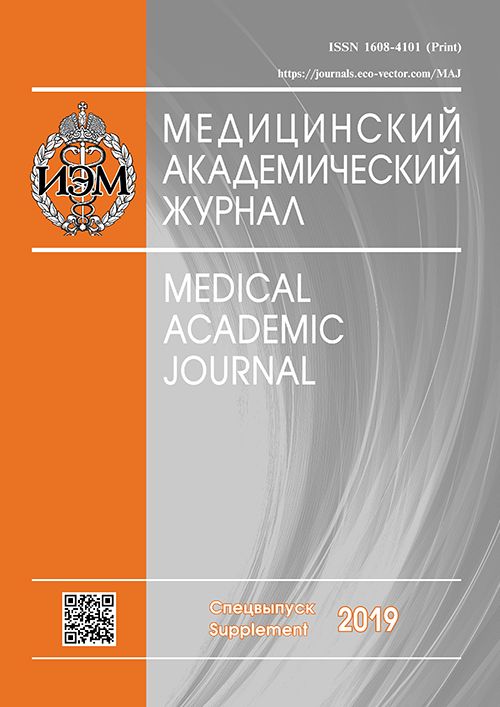BACTENECINS AS CELL-PENETRATING PEPTIDES
- Authors: Shamova OV1, Nazarov AS1, Kopeykin PM1, Kudryavtsev IV1, Grudinina NA1, Andreeva EA1, Milman BL1, Orlov DS1
-
Affiliations:
- Institute of Experimental Medicine, Saint Petersburg
- Issue: Vol 19, No 1S (2019)
- Pages: 178-179
- Section: Articles
- Published: 15.12.2019
- URL: https://journals.eco-vector.com/MAJ/article/view/19387
- ID: 19387
Cite item
Full Text
Abstract
Full Text
Introduction. A problem of drug delivery to the specific targets is of utmost importance in practical medicine. Many of antitumor preparations cannot effectively penetrate across membranes of malignant cells and need carriers to get to their intracellular targets. Cell-penetrating peptides (CPPs) are known as such carriers that are able to deliver varied cargos (proteins, nucleic acids, nanoparticles, liposomes, etc.) into eukaryotic cells. Despite many CPPs have been described: penetratin, fragments of viral proteins - TATp, peptide V22, etc., there is a need of a search of novel CPPs since the efficacy of existing peptides is not high for all types of tumor cells, the cell and tissue selectivity is not sufficient, and the stability of the peptides in biological liquids is low [3]. It was reported that some peptides of the innate immune system also can serve as CPPs [2]. The aim of the present study was an investigation of an ability of several cationic peptides - caprine bactenecins (ChBac5, ChBac3.4, mini-ChBac7.5Na and their analogous) to penetrate into varied types of mammalian cells in vitro. The listed peptides have been previously isolated by us from leukocytes of the domestic goat Capra hircus and their antibiotic Material and methods. The studied peptides were obtained by solid-phase synthesis on the automatic peptide synthesizer Symphony X (Protein Technologies, USA). The peptides were conjugated with a fluorescent dye BODIPY FL (Invitrogen, USA, Ex/Em 503/512) according to the dye manufacturer instruction. Labeled peptides were purified by high-performance liquid chromatography and their molecular masses were determined by MALDI TOF MS. Cellular uptake of the tagged peptides into cultured tumor and normal cells in vitro was quantitatively assessed usingflow-cytometry on the device Navios (Beckman Coulter, USA) and observed by means of confocal microscopy (Leica TCS SL microscope and Zeiss LSM 510 Meta microscope, Germany). Results and discussion. According to flow cytometry data, all studied peptides penetrate into target cells in non-toxic concentrations (0.2-5 µM) and within 5 minutes after adding to a cell culture can be detected in cells. The cellular uptake of the BODIPY-tagged bactenecins is similar or higher than that of a peptide TAT (47-57 fragment) labeled by the same protocol and used as a standard cell-penetrating peptide, described in the literature. The obtained values depend on the cell type and differ for each of the studied peptides. Bactenecins more effectively penetrate into tumor cells (K-562 - human erythromyeloid leukemia, THP-1 - human monocytic leukemia, U-937 - human hystiocytic limphoma) comparing to normal human cells (peripheral blood mononuclear cells (PMBC), erythrocytes of healthy donors) in vitro. The highest rates of the internalization into tumor cells have been demonstrated for a C-terminal fragment of ChBac5: this peptide 10 times more effectively penetrates into malignant cells THP-1 than into human PMBC and 2 times more effectively into cells K562 than into the normal mononuclear cells. All studied peptides are practically not able to internalize into erythrocytes in non-hemolytic concentrations. Study of an influence of the target cells energy metabolism and the temperature of the cultural medium on the peptides cell-penetrating efficacy revealed that lowering the temperature to 4 °C is the most critical parameter that decreases the peptides cellular uptake. Confocal microscopy data confirm the established property of the investigated peptides to penetrate into cells. Conclusion. The obtained data confirm the prospect of further investigations of bactenecins as prototypes of new effective CPPs for drug delivery into malignant or infected cells. This wok was supported by RFBR grant No. 17-04-02177a.About the authors
O V Shamova
Institute of Experimental Medicine, Saint Petersburg
A S Nazarov
Institute of Experimental Medicine, Saint Petersburg
P M Kopeykin
Institute of Experimental Medicine, Saint Petersburg
I V Kudryavtsev
Institute of Experimental Medicine, Saint Petersburg
N A Grudinina
Institute of Experimental Medicine, Saint Petersburg
E A Andreeva
Institute of Experimental Medicine, Saint Petersburg
B L Milman
Institute of Experimental Medicine, Saint Petersburg
D S Orlov
Institute of Experimental Medicine, Saint Petersburg
References
- Reissmann S. Cell penetration: scope and limitations by the application of cell-penetrating peptides. J. Pept Sci. 2014;20(10):760-784.
- Splith K, Neundorf I. Antimicrobial peptides with cell-penetrating peptide properties and vice versa. Eur. Biophys. J. 2011;40:387-397.
- Shamova OV, Orlov DS, Zharkova MS, et al. Minibactenecins ChBac7.Nα and ChBac7.Nβ - antimicrobial peptides from leukocytes of the goat Capra hircus. Acta Naturae. 2016;8(3):136-146.
Supplementary files







